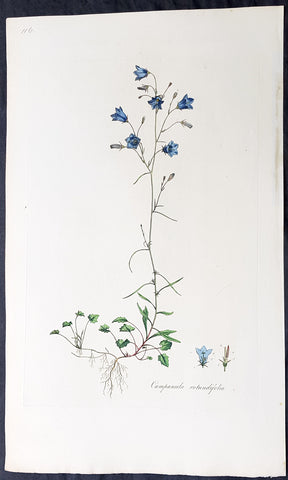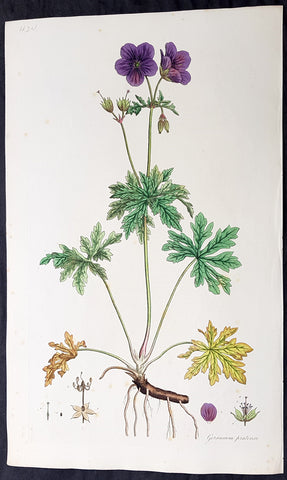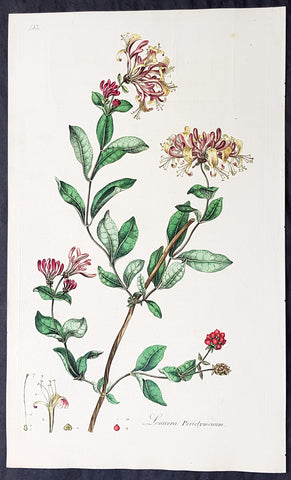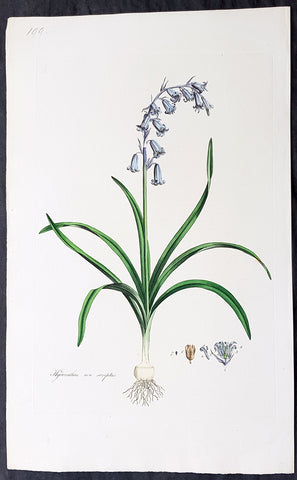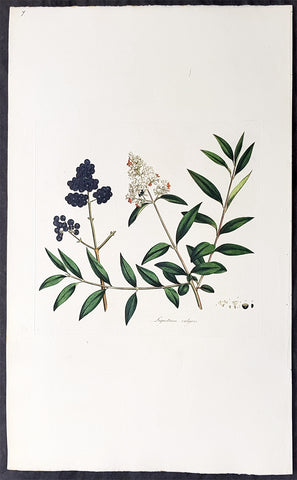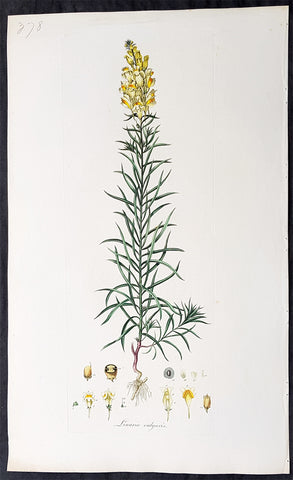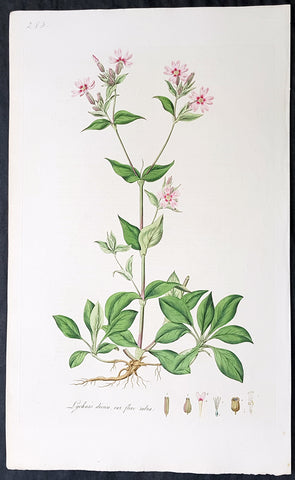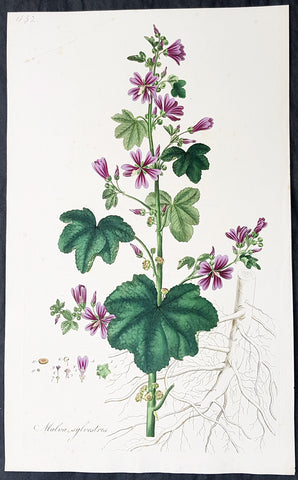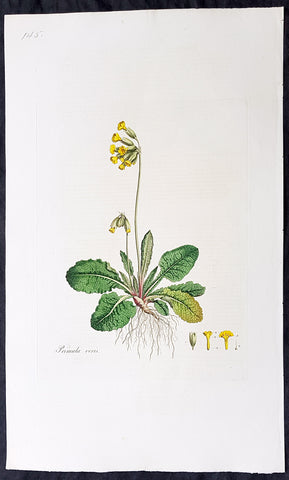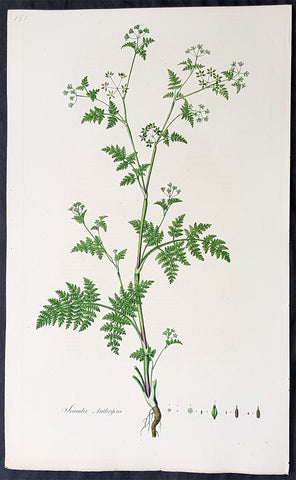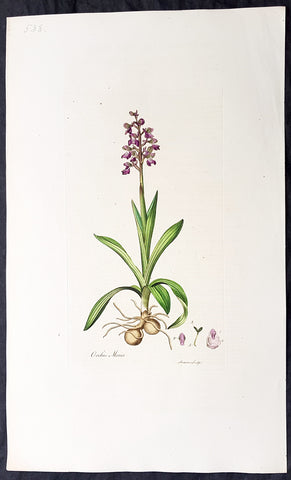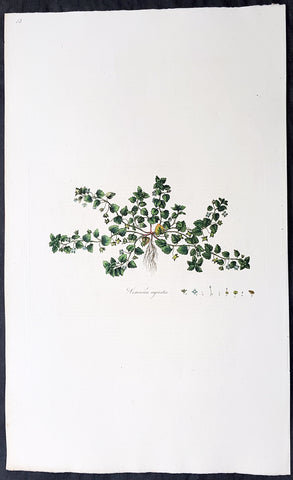
William Curtis (1746-1799)
Profile :
Curtis was trained in pharmaceuticals, articled to his Uncle. At the age of 27, he was appointed, Demonstrator and 'Praefectus Horti' to the Chelsea Society of Apothecaries. His passion, however, was botany, his forte being British flora. His first project was funded by Lord Bute and consisted of illustrations and descriptions of the wild flowers within a 10 mile radius of London. This was called Flora Londinesis and was published in 1777. Having completed this task, he resigned from this post and began a collection consisting of 70 folios. This collection was not very profitable, gardeners were not interested in 'weeds', they wanted to see garden flowers. Because gardeners were more affluent than botanists at the time, he discontinued his work on this publication and began work on the Botanical Magazine which would cater for their tastes.
This periodical: The Botanical Magazine, was extremely popular, its first publication being in 1787. Of the many horticultural and botanical periodicals produced since this, the foremost, there is not one among them that compares to the extensive work of William Curtis, his passion for botany being his motivation. After the death of Curtis, in 1799, the Botanical Magazine was continued by a friend on his, John Sims and was then passed on to William Jackson Hooker. It was continued for almost two centuries until 1984 when it was integrated with the The Kew Magazine.
The principal artists employed for this work (in Curtis' Lifetime) were William Kilburn, James Sowerby and Sydenham T. Edwards. All of which worked with Curtis for 28 years and were responsible for the exquisite quality of the plates contained within the magazine. Later illustrators after Curtis died were W. J. Hooker, Walter Hood Fitch and his nephew, John Nugent Fitch. The Fitches being the sole illustrators for 71 years.
William Curtis
1777 W. Curtis Large Antique Botanical Print Campanula rotundifolia - Bluebell
- Title : Campanula Rotundifolia. Heath Bell-Flower
- Ref #: 93481-1
- Size: 19in x 11 1/2in (490mm x 295mm)
- Date : 1777 - 1798
- Condition: (A+) Fine Condition
Description:
This beautifully hand coloured original copper-plate engraved antique botanical print by William Curtis was published in his large 1st edition folio edition of his famous and most enduring 6 volumes of Flora Londinensis: or, plates and descriptions of such plants as grow wild in the environs of London: with their places of growth, and times of flowering, their several names according to Linnæus and other authors: with a particular description of each plant in Latin and English. To which are added, their several uses in medicine, agriculture, rural economy and other arts. published between 1777 & 1798.
Also accompanying the print is the original text page, giving an in-depth description of the plant and its attributes.
General Definitions:
Paper thickness and quality: - Heavy and stable
Paper color : - off white
Age of map color: - Original
Colors used: - Yellow, green, blue, pink
General color appearance: - Authentic
Paper size: - 19in x 11 1/2in (490mm x 295mm)
Plate size: - 9 1/2in x 6 1/2in (240mm x 165mm)
Margins: - Min 1in (25mm)
Imperfections:
Margins: - None
Plate area: - None
Verso: - None
Background:
Flora Londinensis is a book that described the flora found in the London region of the mid 18th century. The Flora was published by William Curtis in six large volumes. The descriptions of the plants included hand-coloured copperplate plates by botanical artists such as James Sowerby, Sydenham Edwards and William Kilburn.
The full title is Flora Londinensis: or, plates and descriptions of such plants as grow wild in the environs of London: with their places of growth, and times of flowering, their several names according to Linnæus and other authors: with a particular description of each plant in Latin and English. To which are added, their several uses in medicine, agriculture, rural œconomy and other arts.
The first volume was produced in 1777 and the final one, containing a title and an index, was published in 1798. A binary name is given for each species in the survey; common and other names are also provided. Previous works on the flora of Britain had been intended for scientists, apothecaries, and herbalists, while Flora Londinensis was written for the general reader. The appealing plates also provided botanical details which could assist in the identification of a species.
Curtis was praefectus horti (Director, Society of Apothecaries) at the Chelsea Physic Garden and a botanist with a broad knowledge of exotic species. However, Flora Londinensis covered the territory most familiar to him -- the flowering species within a 10-mile radius of London. He commissioned several painters to produce hand-coloured copper engravings to accompany the pages. Curtis wrote the descriptions and managed the publishing and sales of the volumes, producing six fascicles of twelve issues, each containing six plates. The final survey eventually came to include many species found in southern England and a few others.
Despite praise for the volumes, no more than 300 copies were produced. Many other works were to be issued but it was not yet economical to produce a more affordable volume. Curtiss The Botanical Magazine would be a greater financial success. Sowerby, who helped to publish the volumes and give over seventy of the plates, went on to produce natural history publications in a similar format.
The work was enlarged by William J. Hooker, who published an edition with his own text in 1817 and 1828. This enlargement was even more comprehensive, by including species from the other British Isles.
Curtis, William 1746 - 1799
Curtis was an English botanist and entomologist, who was born at Alton, Hampshire, site of the Curtis Museum.
Curtis began as an apothecary, before turning his attention to botany and other natural history. The publications he prepared reached a wider audience than early works on the subject had intended. At the age of 25 he produced Instructions for collecting and preserving insects; particularly moths and butterflies.
Curtis was demonstrator of plants and Praefectus Horti at the Chelsea Physic Garden from 1771 to 1777. He established his own London Botanic Garden at Lambeth in 1779, moving to Brompton in 1789. He published Flora Londinensis (6 volumes, 1777–1798), a pioneering work in that it devoted itself to urban nature. Financial success was not found, but he went on the publish The Botanical Magazine in 1787, a work that would also feature hand coloured plates by artists such as James Sowerby and Sydenham Edwards. (William Kilburn is often erroneously cited as having contributed plates to Curtis\\\' Botanical Magazine. Though he did provide illustrations to Flora Londinensis, his association with Curtis seems to have ended by 1977, 10 years before the first publication of the Botanical Magazine)
Curtis was to gain wealth from the ventures into publishing, short sales on Londinensis were offset by over 3,000 copies of the magazine. Curtis said they had each brought \\\'pudding or praise\\\'.
The genus Curtisia is named in his honour. His publication was continued as the esteemed botanical publication, Curtis\\\'s Botanical Magazine. The noted natural history illustrators, James Sowerby and Sydenham Edwards both found a start with the eminent magazine.
He is commemorated in a stained glass window at St. Mary\\\'s Church, Battersea, as many of his samples were collected from the churchyard there.
This botanist is denoted by the author abbreviation Curtis when citing a botanical name.
1777 W. Curtis Large Antique Botanical Print Geranium Pratense, Meadow Geranium
- Title : Geranium Pratense. Crowfoot-Leaved Cranes Bill
- Ref #: 93480
- Size: 19in x 11 1/2in (490mm x 295mm)
- Date : 1777 - 1798
- Condition: (A) Very Good Condition
Description:
This beautifully hand coloured original copper-plate engraved antique botanical print by William Curtis was published in his large 1st edition folio edition of his famous and most enduring 6 volumes of Flora Londinensis: or, plates and descriptions of such plants as grow wild in the environs of London: with their places of growth, and times of flowering, their several names according to Linnæus and other authors: with a particular description of each plant in Latin and English. To which are added, their several uses in medicine, agriculture, rural economy and other arts. published between 1777 & 1798.
Also accompanying the print is the original text page, giving an in-depth description of the plant and its attributes.
General Definitions:
Paper thickness and quality: - Heavy and stable
Paper color : - off white
Age of map color: - Original
Colors used: - Yellow, green, blue, pink
General color appearance: - Authentic
Paper size: - 19in x 11 1/2in (490mm x 295mm)
Plate size: - 9 1/2in x 6 1/2in (240mm x 165mm)
Margins: - Min 1in (25mm)
Imperfections:
Margins: - Light top left corner crease
Plate area: - Light spotting
Verso: - None
Background:
Flora Londinensis is a book that described the flora found in the London region of the mid 18th century. The Flora was published by William Curtis in six large volumes. The descriptions of the plants included hand-coloured copperplate plates by botanical artists such as James Sowerby, Sydenham Edwards and William Kilburn.
The full title is Flora Londinensis: or, plates and descriptions of such plants as grow wild in the environs of London: with their places of growth, and times of flowering, their several names according to Linnæus and other authors: with a particular description of each plant in Latin and English. To which are added, their several uses in medicine, agriculture, rural œconomy and other arts.
The first volume was produced in 1777 and the final one, containing a title and an index, was published in 1798. A binary name is given for each species in the survey; common and other names are also provided. Previous works on the flora of Britain had been intended for scientists, apothecaries, and herbalists, while Flora Londinensis was written for the general reader. The appealing plates also provided botanical details which could assist in the identification of a species.
Curtis was praefectus horti (Director, Society of Apothecaries) at the Chelsea Physic Garden and a botanist with a broad knowledge of exotic species. However, Flora Londinensis covered the territory most familiar to him -- the flowering species within a 10-mile radius of London. He commissioned several painters to produce hand-coloured copper engravings to accompany the pages. Curtis wrote the descriptions and managed the publishing and sales of the volumes, producing six fascicles of twelve issues, each containing six plates. The final survey eventually came to include many species found in southern England and a few others.
Despite praise for the volumes, no more than 300 copies were produced. Many other works were to be issued but it was not yet economical to produce a more affordable volume. Curtiss The Botanical Magazine would be a greater financial success. Sowerby, who helped to publish the volumes and give over seventy of the plates, went on to produce natural history publications in a similar format.
The work was enlarged by William J. Hooker, who published an edition with his own text in 1817 and 1828. This enlargement was even more comprehensive, by including species from the other British Isles.
Curtis, William 1746 - 1799
Curtis was an English botanist and entomologist, who was born at Alton, Hampshire, site of the Curtis Museum.
Curtis began as an apothecary, before turning his attention to botany and other natural history. The publications he prepared reached a wider audience than early works on the subject had intended. At the age of 25 he produced Instructions for collecting and preserving insects; particularly moths and butterflies.
Curtis was demonstrator of plants and Praefectus Horti at the Chelsea Physic Garden from 1771 to 1777. He established his own London Botanic Garden at Lambeth in 1779, moving to Brompton in 1789. He published Flora Londinensis (6 volumes, 1777–1798), a pioneering work in that it devoted itself to urban nature. Financial success was not found, but he went on the publish The Botanical Magazine in 1787, a work that would also feature hand coloured plates by artists such as James Sowerby and Sydenham Edwards. (William Kilburn is often erroneously cited as having contributed plates to Curtis\\\' Botanical Magazine. Though he did provide illustrations to Flora Londinensis, his association with Curtis seems to have ended by 1977, 10 years before the first publication of the Botanical Magazine)
Curtis was to gain wealth from the ventures into publishing, short sales on Londinensis were offset by over 3,000 copies of the magazine. Curtis said they had each brought \\\'pudding or praise\\\'.
The genus Curtisia is named in his honour. His publication was continued as the esteemed botanical publication, Curtis\\\'s Botanical Magazine. The noted natural history illustrators, James Sowerby and Sydenham Edwards both found a start with the eminent magazine.
He is commemorated in a stained glass window at St. Mary\\\'s Church, Battersea, as many of his samples were collected from the churchyard there.
This botanist is denoted by the author abbreviation Curtis when citing a botanical name.
1777 W. Curtis Large Antique Botanical Print Lonicera Periclymenum - Honeysuckle
- Title : Lonicera Periclymenum. Honeysuckle or Woodbine
- Ref #: 93471
- Size: 19in x 11 1/2in (490mm x 295mm)
- Date : 1777 - 1798
- Condition: (A+) Fine Condition
Description:
This beautifully hand coloured original copper-plate engraved antique botanical print by William Curtis was published in his large 1st edition folio edition of his famous and most enduring 6 volumes of Flora Londinensis: or, plates and descriptions of such plants as grow wild in the environs of London: with their places of growth, and times of flowering, their several names according to Linnæus and other authors: with a particular description of each plant in Latin and English. To which are added, their several uses in medicine, agriculture, rural economy and other arts. published between 1777 & 1798.
Also accompanying the print is the original text page, giving an in-depth description of the plant and its attributes.
General Definitions:
Paper thickness and quality: - Heavy and stable
Paper color : - off white
Age of map color: - Original
Colors used: - Yellow, green, blue, pink
General color appearance: - Authentic
Paper size: - 19in x 11 1/2in (490mm x 295mm)
Plate size: - 9 1/2in x 6 1/2in (240mm x 165mm)
Margins: - Min 1in (25mm)
Imperfections:
Margins: - None
Plate area: - None
Verso: - None
Background:
Flora Londinensis is a book that described the flora found in the London region of the mid 18th century. The Flora was published by William Curtis in six large volumes. The descriptions of the plants included hand-coloured copperplate plates by botanical artists such as James Sowerby, Sydenham Edwards and William Kilburn.
The full title is Flora Londinensis: or, plates and descriptions of such plants as grow wild in the environs of London: with their places of growth, and times of flowering, their several names according to Linnæus and other authors: with a particular description of each plant in Latin and English. To which are added, their several uses in medicine, agriculture, rural œconomy and other arts.
The first volume was produced in 1777 and the final one, containing a title and an index, was published in 1798. A binary name is given for each species in the survey; common and other names are also provided. Previous works on the flora of Britain had been intended for scientists, apothecaries, and herbalists, while Flora Londinensis was written for the general reader. The appealing plates also provided botanical details which could assist in the identification of a species.
Curtis was praefectus horti (Director, Society of Apothecaries) at the Chelsea Physic Garden and a botanist with a broad knowledge of exotic species. However, Flora Londinensis covered the territory most familiar to him -- the flowering species within a 10-mile radius of London. He commissioned several painters to produce hand-coloured copper engravings to accompany the pages. Curtis wrote the descriptions and managed the publishing and sales of the volumes, producing six fascicles of twelve issues, each containing six plates. The final survey eventually came to include many species found in southern England and a few others.
Despite praise for the volumes, no more than 300 copies were produced. Many other works were to be issued but it was not yet economical to produce a more affordable volume. Curtiss The Botanical Magazine would be a greater financial success. Sowerby, who helped to publish the volumes and give over seventy of the plates, went on to produce natural history publications in a similar format.
The work was enlarged by William J. Hooker, who published an edition with his own text in 1817 and 1828. This enlargement was even more comprehensive, by including species from the other British Isles.
Curtis, William 1746 - 1799
Curtis was an English botanist and entomologist, who was born at Alton, Hampshire, site of the Curtis Museum.
Curtis began as an apothecary, before turning his attention to botany and other natural history. The publications he prepared reached a wider audience than early works on the subject had intended. At the age of 25 he produced Instructions for collecting and preserving insects; particularly moths and butterflies.
Curtis was demonstrator of plants and Praefectus Horti at the Chelsea Physic Garden from 1771 to 1777. He established his own London Botanic Garden at Lambeth in 1779, moving to Brompton in 1789. He published Flora Londinensis (6 volumes, 1777–1798), a pioneering work in that it devoted itself to urban nature. Financial success was not found, but he went on the publish The Botanical Magazine in 1787, a work that would also feature hand coloured plates by artists such as James Sowerby and Sydenham Edwards. (William Kilburn is often erroneously cited as having contributed plates to Curtis\\\' Botanical Magazine. Though he did provide illustrations to Flora Londinensis, his association with Curtis seems to have ended by 1977, 10 years before the first publication of the Botanical Magazine)
Curtis was to gain wealth from the ventures into publishing, short sales on Londinensis were offset by over 3,000 copies of the magazine. Curtis said they had each brought \\\'pudding or praise\\\'.
The genus Curtisia is named in his honour. His publication was continued as the esteemed botanical publication, Curtis\\\'s Botanical Magazine. The noted natural history illustrators, James Sowerby and Sydenham Edwards both found a start with the eminent magazine.
He is commemorated in a stained glass window at St. Mary\\\'s Church, Battersea, as many of his samples were collected from the churchyard there.
This botanist is denoted by the author abbreviation Curtis when citing a botanical name.
1777 W. Curtis Large Antique Botanical Print of Hyacinthus Non-Scriptus Bluebell
- Title : Hyacinthus Non-Scriptus. English Hyacinth or Harebell
- Ref #: 93476
- Size: 19in x 11 1/2in (490mm x 295mm)
- Date : 1777 - 1798
- Condition: (A+) Fine Condition
Description:
This beautifully hand coloured original copper-plate engraved antique botanical print by William Curtis was published in his large 1st edition folio edition of his famous and most enduring 6 volumes of Flora Londinensis: or, plates and descriptions of such plants as grow wild in the environs of London: with their places of growth, and times of flowering, their several names according to Linnæus and other authors: with a particular description of each plant in Latin and English. To which are added, their several uses in medicine, agriculture, rural economy and other arts. published between 1777 & 1798.
Also accompanying the print is the original text page, giving an in-depth description of the plant and its attributes.
General Definitions:
Paper thickness and quality: - Heavy and stable
Paper color : - off white
Age of map color: - Original
Colors used: - Yellow, green, blue, pink
General color appearance: - Authentic
Paper size: - 19in x 11 1/2in (490mm x 295mm)
Plate size: - 9 1/2in x 6 1/2in (240mm x 165mm)
Margins: - Min 1in (25mm)
Imperfections:
Margins: - None
Plate area: - None
Verso: - None
Background:
Flora Londinensis is a book that described the flora found in the London region of the mid 18th century. The Flora was published by William Curtis in six large volumes. The descriptions of the plants included hand-coloured copperplate plates by botanical artists such as James Sowerby, Sydenham Edwards and William Kilburn.
The full title is Flora Londinensis: or, plates and descriptions of such plants as grow wild in the environs of London: with their places of growth, and times of flowering, their several names according to Linnæus and other authors: with a particular description of each plant in Latin and English. To which are added, their several uses in medicine, agriculture, rural œconomy and other arts.
The first volume was produced in 1777 and the final one, containing a title and an index, was published in 1798. A binary name is given for each species in the survey; common and other names are also provided. Previous works on the flora of Britain had been intended for scientists, apothecaries, and herbalists, while Flora Londinensis was written for the general reader. The appealing plates also provided botanical details which could assist in the identification of a species.
Curtis was praefectus horti (Director, Society of Apothecaries) at the Chelsea Physic Garden and a botanist with a broad knowledge of exotic species. However, Flora Londinensis covered the territory most familiar to him -- the flowering species within a 10-mile radius of London. He commissioned several painters to produce hand-coloured copper engravings to accompany the pages. Curtis wrote the descriptions and managed the publishing and sales of the volumes, producing six fascicles of twelve issues, each containing six plates. The final survey eventually came to include many species found in southern England and a few others.
Despite praise for the volumes, no more than 300 copies were produced. Many other works were to be issued but it was not yet economical to produce a more affordable volume. Curtiss The Botanical Magazine would be a greater financial success. Sowerby, who helped to publish the volumes and give over seventy of the plates, went on to produce natural history publications in a similar format.
The work was enlarged by William J. Hooker, who published an edition with his own text in 1817 and 1828. This enlargement was even more comprehensive, by including species from the other British Isles.
Curtis, William 1746 - 1799
Curtis was an English botanist and entomologist, who was born at Alton, Hampshire, site of the Curtis Museum.
Curtis began as an apothecary, before turning his attention to botany and other natural history. The publications he prepared reached a wider audience than early works on the subject had intended. At the age of 25 he produced Instructions for collecting and preserving insects; particularly moths and butterflies.
Curtis was demonstrator of plants and Praefectus Horti at the Chelsea Physic Garden from 1771 to 1777. He established his own London Botanic Garden at Lambeth in 1779, moving to Brompton in 1789. He published Flora Londinensis (6 volumes, 1777–1798), a pioneering work in that it devoted itself to urban nature. Financial success was not found, but he went on the publish The Botanical Magazine in 1787, a work that would also feature hand coloured plates by artists such as James Sowerby and Sydenham Edwards. (William Kilburn is often erroneously cited as having contributed plates to Curtis\\\' Botanical Magazine. Though he did provide illustrations to Flora Londinensis, his association with Curtis seems to have ended by 1977, 10 years before the first publication of the Botanical Magazine)
Curtis was to gain wealth from the ventures into publishing, short sales on Londinensis were offset by over 3,000 copies of the magazine. Curtis said they had each brought \\\'pudding or praise\\\'.
The genus Curtisia is named in his honour. His publication was continued as the esteemed botanical publication, Curtis\\\'s Botanical Magazine. The noted natural history illustrators, James Sowerby and Sydenham Edwards both found a start with the eminent magazine.
He is commemorated in a stained glass window at St. Mary\\\'s Church, Battersea, as many of his samples were collected from the churchyard there.
This botanist is denoted by the author abbreviation Curtis when citing a botanical name.
1777 W. Curtis Large Antique Botanical Print of Ligustrum vulgare or Privet Bush
- Title : Liustrum Vulgare. Privet, or Prim.
- Ref #: 93475
- Size: 19in x 11 1/2in (490mm x 295mm)
- Date : 1777 - 1798
- Condition: (A+) Fine Condition
Description:
This beautifully hand coloured original copper-plate engraved antique botanical print by William Curtis was published in his large 1st edition folio edition of his famous and most enduring 6 volumes of Flora Londinensis: or, plates and descriptions of such plants as grow wild in the environs of London: with their places of growth, and times of flowering, their several names according to Linnæus and other authors: with a particular description of each plant in Latin and English. To which are added, their several uses in medicine, agriculture, rural economy and other arts. published between 1777 & 1798.
Also accompanying the print is the original text page, giving an in-depth description of the plant and its attributes.
General Definitions:
Paper thickness and quality: - Heavy and stable
Paper color : - off white
Age of map color: - Original
Colors used: - Yellow, green, blue, pink
General color appearance: - Authentic
Paper size: - 19in x 11 1/2in (490mm x 295mm)
Plate size: - 9 1/2in x 6 1/2in (240mm x 165mm)
Margins: - Min 1in (25mm)
Imperfections:
Margins: - None
Plate area: - None
Verso: - None
Background:
Flora Londinensis is a book that described the flora found in the London region of the mid 18th century. The Flora was published by William Curtis in six large volumes. The descriptions of the plants included hand-coloured copperplate plates by botanical artists such as James Sowerby, Sydenham Edwards and William Kilburn.
The full title is Flora Londinensis: or, plates and descriptions of such plants as grow wild in the environs of London: with their places of growth, and times of flowering, their several names according to Linnæus and other authors: with a particular description of each plant in Latin and English. To which are added, their several uses in medicine, agriculture, rural œconomy and other arts.
The first volume was produced in 1777 and the final one, containing a title and an index, was published in 1798. A binary name is given for each species in the survey; common and other names are also provided. Previous works on the flora of Britain had been intended for scientists, apothecaries, and herbalists, while Flora Londinensis was written for the general reader. The appealing plates also provided botanical details which could assist in the identification of a species.
Curtis was praefectus horti (Director, Society of Apothecaries) at the Chelsea Physic Garden and a botanist with a broad knowledge of exotic species. However, Flora Londinensis covered the territory most familiar to him -- the flowering species within a 10-mile radius of London. He commissioned several painters to produce hand-coloured copper engravings to accompany the pages. Curtis wrote the descriptions and managed the publishing and sales of the volumes, producing six fascicles of twelve issues, each containing six plates. The final survey eventually came to include many species found in southern England and a few others.
Despite praise for the volumes, no more than 300 copies were produced. Many other works were to be issued but it was not yet economical to produce a more affordable volume. Curtiss The Botanical Magazine would be a greater financial success. Sowerby, who helped to publish the volumes and give over seventy of the plates, went on to produce natural history publications in a similar format.
The work was enlarged by William J. Hooker, who published an edition with his own text in 1817 and 1828. This enlargement was even more comprehensive, by including species from the other British Isles.
Curtis, William 1746 - 1799
Curtis was an English botanist and entomologist, who was born at Alton, Hampshire, site of the Curtis Museum.
Curtis began as an apothecary, before turning his attention to botany and other natural history. The publications he prepared reached a wider audience than early works on the subject had intended. At the age of 25 he produced Instructions for collecting and preserving insects; particularly moths and butterflies.
Curtis was demonstrator of plants and Praefectus Horti at the Chelsea Physic Garden from 1771 to 1777. He established his own London Botanic Garden at Lambeth in 1779, moving to Brompton in 1789. He published Flora Londinensis (6 volumes, 1777–1798), a pioneering work in that it devoted itself to urban nature. Financial success was not found, but he went on the publish The Botanical Magazine in 1787, a work that would also feature hand coloured plates by artists such as James Sowerby and Sydenham Edwards. (William Kilburn is often erroneously cited as having contributed plates to Curtis\\\' Botanical Magazine. Though he did provide illustrations to Flora Londinensis, his association with Curtis seems to have ended by 1977, 10 years before the first publication of the Botanical Magazine)
Curtis was to gain wealth from the ventures into publishing, short sales on Londinensis were offset by over 3,000 copies of the magazine. Curtis said they had each brought \\\'pudding or praise\\\'.
The genus Curtisia is named in his honour. His publication was continued as the esteemed botanical publication, Curtis\\\'s Botanical Magazine. The noted natural history illustrators, James Sowerby and Sydenham Edwards both found a start with the eminent magazine.
He is commemorated in a stained glass window at St. Mary\\\'s Church, Battersea, as many of his samples were collected from the churchyard there.
This botanist is denoted by the author abbreviation Curtis when citing a botanical name.
1777 W. Curtis Large Antique Botanical Print of Linaria Vulgaris Yellow Toadflax
- Title : Linaria Vulgaris. Yellow Toadflax
- Ref #: 93470
- Size: 19in x 11 1/2in (490mm x 295mm)
- Date : 1777 - 1798
- Condition: (A+) Fine Condition
Description:
This beautifully hand coloured original copper-plate engraved antique botanical print by William Curtis was published in his large 1st edition folio edition of his famous and most enduring 6 volumes of Flora Londinensis: or, plates and descriptions of such plants as grow wild in the environs of London: with their places of growth, and times of flowering, their several names according to Linnæus and other authors: with a particular description of each plant in Latin and English. To which are added, their several uses in medicine, agriculture, rural economy and other arts. published between 1777 & 1798.
Also accompanying the print is the original text page, giving an in-depth description of the plant and its attributes.
General Definitions:
Paper thickness and quality: - Heavy and stable
Paper color : - off white
Age of map color: - Original
Colors used: - Yellow, green, blue, pink
General color appearance: - Authentic
Paper size: - 19in x 11 1/2in (490mm x 295mm)
Plate size: - 9 1/2in x 6 1/2in (240mm x 165mm)
Margins: - Min 1in (25mm)
Imperfections:
Margins: - None
Plate area: - None
Verso: - None
Background:
Flora Londinensis is a book that described the flora found in the London region of the mid 18th century. The Flora was published by William Curtis in six large volumes. The descriptions of the plants included hand-coloured copperplate plates by botanical artists such as James Sowerby, Sydenham Edwards and William Kilburn.
The full title is Flora Londinensis: or, plates and descriptions of such plants as grow wild in the environs of London: with their places of growth, and times of flowering, their several names according to Linnæus and other authors: with a particular description of each plant in Latin and English. To which are added, their several uses in medicine, agriculture, rural œconomy and other arts.
The first volume was produced in 1777 and the final one, containing a title and an index, was published in 1798. A binary name is given for each species in the survey; common and other names are also provided. Previous works on the flora of Britain had been intended for scientists, apothecaries, and herbalists, while Flora Londinensis was written for the general reader. The appealing plates also provided botanical details which could assist in the identification of a species.
Curtis was praefectus horti (Director, Society of Apothecaries) at the Chelsea Physic Garden and a botanist with a broad knowledge of exotic species. However, Flora Londinensis covered the territory most familiar to him -- the flowering species within a 10-mile radius of London. He commissioned several painters to produce hand-coloured copper engravings to accompany the pages. Curtis wrote the descriptions and managed the publishing and sales of the volumes, producing six fascicles of twelve issues, each containing six plates. The final survey eventually came to include many species found in southern England and a few others.
Despite praise for the volumes, no more than 300 copies were produced. Many other works were to be issued but it was not yet economical to produce a more affordable volume. Curtiss The Botanical Magazine would be a greater financial success. Sowerby, who helped to publish the volumes and give over seventy of the plates, went on to produce natural history publications in a similar format.
The work was enlarged by William J. Hooker, who published an edition with his own text in 1817 and 1828. This enlargement was even more comprehensive, by including species from the other British Isles.
Curtis, William 1746 - 1799
Curtis was an English botanist and entomologist, who was born at Alton, Hampshire, site of the Curtis Museum.
Curtis began as an apothecary, before turning his attention to botany and other natural history. The publications he prepared reached a wider audience than early works on the subject had intended. At the age of 25 he produced Instructions for collecting and preserving insects; particularly moths and butterflies.
Curtis was demonstrator of plants and Praefectus Horti at the Chelsea Physic Garden from 1771 to 1777. He established his own London Botanic Garden at Lambeth in 1779, moving to Brompton in 1789. He published Flora Londinensis (6 volumes, 1777–1798), a pioneering work in that it devoted itself to urban nature. Financial success was not found, but he went on the publish The Botanical Magazine in 1787, a work that would also feature hand coloured plates by artists such as James Sowerby and Sydenham Edwards. (William Kilburn is often erroneously cited as having contributed plates to Curtis\\\' Botanical Magazine. Though he did provide illustrations to Flora Londinensis, his association with Curtis seems to have ended by 1977, 10 years before the first publication of the Botanical Magazine)
Curtis was to gain wealth from the ventures into publishing, short sales on Londinensis were offset by over 3,000 copies of the magazine. Curtis said they had each brought \\\'pudding or praise\\\'.
The genus Curtisia is named in his honour. His publication was continued as the esteemed botanical publication, Curtis\\\'s Botanical Magazine. The noted natural history illustrators, James Sowerby and Sydenham Edwards both found a start with the eminent magazine.
He is commemorated in a stained glass window at St. Mary\\\'s Church, Battersea, as many of his samples were collected from the churchyard there.
This botanist is denoted by the author abbreviation Curtis when citing a botanical name.
1777 W. Curtis Large Antique Botanical Print of Lychnis Dioica - Red Campion
- Title : Lychnis Dioica flore rubro. Red Campion
- Ref #: 93473
- Size: 19in x 11 1/2in (490mm x 295mm)
- Date : 1777 - 1798
- Condition: (A+) Fine Condition
Description:
This beautifully hand coloured original copper-plate engraved antique botanical print by William Curtis was published in his large 1st edition folio edition of his famous and most enduring 6 volumes of Flora Londinensis: or, plates and descriptions of such plants as grow wild in the environs of London: with their places of growth, and times of flowering, their several names according to Linnæus and other authors: with a particular description of each plant in Latin and English. To which are added, their several uses in medicine, agriculture, rural economy and other arts. published between 1777 & 1798.
Also accompanying the print is the original text page, giving an in-depth description of the plant and its attributes.
General Definitions:
Paper thickness and quality: - Heavy and stable
Paper color : - off white
Age of map color: - Original
Colors used: - Yellow, green, blue, pink
General color appearance: - Authentic
Paper size: - 19in x 11 1/2in (490mm x 295mm)
Plate size: - 9 1/2in x 6 1/2in (240mm x 165mm)
Margins: - Min 1in (25mm)
Imperfections:
Margins: - None
Plate area: - None
Verso: - None
Background:
Flora Londinensis is a book that described the flora found in the London region of the mid 18th century. The Flora was published by William Curtis in six large volumes. The descriptions of the plants included hand-coloured copperplate plates by botanical artists such as James Sowerby, Sydenham Edwards and William Kilburn.
The full title is Flora Londinensis: or, plates and descriptions of such plants as grow wild in the environs of London: with their places of growth, and times of flowering, their several names according to Linnæus and other authors: with a particular description of each plant in Latin and English. To which are added, their several uses in medicine, agriculture, rural œconomy and other arts.
The first volume was produced in 1777 and the final one, containing a title and an index, was published in 1798. A binary name is given for each species in the survey; common and other names are also provided. Previous works on the flora of Britain had been intended for scientists, apothecaries, and herbalists, while Flora Londinensis was written for the general reader. The appealing plates also provided botanical details which could assist in the identification of a species.
Curtis was praefectus horti (Director, Society of Apothecaries) at the Chelsea Physic Garden and a botanist with a broad knowledge of exotic species. However, Flora Londinensis covered the territory most familiar to him -- the flowering species within a 10-mile radius of London. He commissioned several painters to produce hand-coloured copper engravings to accompany the pages. Curtis wrote the descriptions and managed the publishing and sales of the volumes, producing six fascicles of twelve issues, each containing six plates. The final survey eventually came to include many species found in southern England and a few others.
Despite praise for the volumes, no more than 300 copies were produced. Many other works were to be issued but it was not yet economical to produce a more affordable volume. Curtiss The Botanical Magazine would be a greater financial success. Sowerby, who helped to publish the volumes and give over seventy of the plates, went on to produce natural history publications in a similar format.
The work was enlarged by William J. Hooker, who published an edition with his own text in 1817 and 1828. This enlargement was even more comprehensive, by including species from the other British Isles.
Curtis, William 1746 - 1799
Curtis was an English botanist and entomologist, who was born at Alton, Hampshire, site of the Curtis Museum.
Curtis began as an apothecary, before turning his attention to botany and other natural history. The publications he prepared reached a wider audience than early works on the subject had intended. At the age of 25 he produced Instructions for collecting and preserving insects; particularly moths and butterflies.
Curtis was demonstrator of plants and Praefectus Horti at the Chelsea Physic Garden from 1771 to 1777. He established his own London Botanic Garden at Lambeth in 1779, moving to Brompton in 1789. He published Flora Londinensis (6 volumes, 1777–1798), a pioneering work in that it devoted itself to urban nature. Financial success was not found, but he went on the publish The Botanical Magazine in 1787, a work that would also feature hand coloured plates by artists such as James Sowerby and Sydenham Edwards. (William Kilburn is often erroneously cited as having contributed plates to Curtis\\\' Botanical Magazine. Though he did provide illustrations to Flora Londinensis, his association with Curtis seems to have ended by 1977, 10 years before the first publication of the Botanical Magazine)
Curtis was to gain wealth from the ventures into publishing, short sales on Londinensis were offset by over 3,000 copies of the magazine. Curtis said they had each brought \\\'pudding or praise\\\'.
The genus Curtisia is named in his honour. His publication was continued as the esteemed botanical publication, Curtis\\\'s Botanical Magazine. The noted natural history illustrators, James Sowerby and Sydenham Edwards both found a start with the eminent magazine.
He is commemorated in a stained glass window at St. Mary\\\'s Church, Battersea, as many of his samples were collected from the churchyard there.
This botanist is denoted by the author abbreviation Curtis when citing a botanical name.
1777 W. Curtis Large Antique Botanical Print of Malva Sylvestris - Common Mallow
- Title : Malva Sylvestris. Common Mallow
- Ref #: 93472
- Size: 19in x 11 1/2in (490mm x 295mm)
- Date : 1777 - 1798
- Condition: (A) Very Good Condition
Description:
This beautifully hand coloured original copper-plate engraved antique botanical print by William Curtis was published in his large 1st edition folio edition of his famous and most enduring 6 volumes of Flora Londinensis: or, plates and descriptions of such plants as grow wild in the environs of London: with their places of growth, and times of flowering, their several names according to Linnæus and other authors: with a particular description of each plant in Latin and English. To which are added, their several uses in medicine, agriculture, rural economy and other arts. published between 1777 & 1798.
Also accompanying the print is the original text page, giving an in-depth description of the plant and its attributes.
General Definitions:
Paper thickness and quality: - Heavy and stable
Paper color : - off white
Age of map color: - Original
Colors used: - Yellow, green, blue, pink
General color appearance: - Authentic
Paper size: - 19in x 11 1/2in (490mm x 295mm)
Plate size: - 9 1/2in x 6 1/2in (240mm x 165mm)
Margins: - Min 1in (25mm)
Imperfections:
Margins: - Light top left corner crease
Plate area: - Light spotting
Verso: - None
Background:
Flora Londinensis is a book that described the flora found in the London region of the mid 18th century. The Flora was published by William Curtis in six large volumes. The descriptions of the plants included hand-coloured copperplate plates by botanical artists such as James Sowerby, Sydenham Edwards and William Kilburn.
The full title is Flora Londinensis: or, plates and descriptions of such plants as grow wild in the environs of London: with their places of growth, and times of flowering, their several names according to Linnæus and other authors: with a particular description of each plant in Latin and English. To which are added, their several uses in medicine, agriculture, rural œconomy and other arts.
The first volume was produced in 1777 and the final one, containing a title and an index, was published in 1798. A binary name is given for each species in the survey; common and other names are also provided. Previous works on the flora of Britain had been intended for scientists, apothecaries, and herbalists, while Flora Londinensis was written for the general reader. The appealing plates also provided botanical details which could assist in the identification of a species.
Curtis was praefectus horti (Director, Society of Apothecaries) at the Chelsea Physic Garden and a botanist with a broad knowledge of exotic species. However, Flora Londinensis covered the territory most familiar to him -- the flowering species within a 10-mile radius of London. He commissioned several painters to produce hand-coloured copper engravings to accompany the pages. Curtis wrote the descriptions and managed the publishing and sales of the volumes, producing six fascicles of twelve issues, each containing six plates. The final survey eventually came to include many species found in southern England and a few others.
Despite praise for the volumes, no more than 300 copies were produced. Many other works were to be issued but it was not yet economical to produce a more affordable volume. Curtiss The Botanical Magazine would be a greater financial success. Sowerby, who helped to publish the volumes and give over seventy of the plates, went on to produce natural history publications in a similar format.
The work was enlarged by William J. Hooker, who published an edition with his own text in 1817 and 1828. This enlargement was even more comprehensive, by including species from the other British Isles.
Curtis, William 1746 - 1799
Curtis was an English botanist and entomologist, who was born at Alton, Hampshire, site of the Curtis Museum.
Curtis began as an apothecary, before turning his attention to botany and other natural history. The publications he prepared reached a wider audience than early works on the subject had intended. At the age of 25 he produced Instructions for collecting and preserving insects; particularly moths and butterflies.
Curtis was demonstrator of plants and Praefectus Horti at the Chelsea Physic Garden from 1771 to 1777. He established his own London Botanic Garden at Lambeth in 1779, moving to Brompton in 1789. He published Flora Londinensis (6 volumes, 1777–1798), a pioneering work in that it devoted itself to urban nature. Financial success was not found, but he went on the publish The Botanical Magazine in 1787, a work that would also feature hand coloured plates by artists such as James Sowerby and Sydenham Edwards. (William Kilburn is often erroneously cited as having contributed plates to Curtis\\\' Botanical Magazine. Though he did provide illustrations to Flora Londinensis, his association with Curtis seems to have ended by 1977, 10 years before the first publication of the Botanical Magazine)
Curtis was to gain wealth from the ventures into publishing, short sales on Londinensis were offset by over 3,000 copies of the magazine. Curtis said they had each brought \\\'pudding or praise\\\'.
The genus Curtisia is named in his honour. His publication was continued as the esteemed botanical publication, Curtis\\\'s Botanical Magazine. The noted natural history illustrators, James Sowerby and Sydenham Edwards both found a start with the eminent magazine.
He is commemorated in a stained glass window at St. Mary\\\'s Church, Battersea, as many of his samples were collected from the churchyard there.
This botanist is denoted by the author abbreviation Curtis when citing a botanical name.
1777 W. Curtis Large Antique Botanical Print of Primula Veris,The Common Cowslip
- Title : Primula Veris. Cowslip
- Ref #: 93477
- Size: 19in x 11 1/2in (490mm x 295mm)
- Date : 1777 - 1798
- Condition: (A+) Fine Condition
Description:
This beautifully hand coloured original copper-plate engraved antique botanical print by William Curtis was published in his large 1st edition folio edition of his famous and most enduring 6 volumes of Flora Londinensis: or, plates and descriptions of such plants as grow wild in the environs of London: with their places of growth, and times of flowering, their several names according to Linnæus and other authors: with a particular description of each plant in Latin and English. To which are added, their several uses in medicine, agriculture, rural economy and other arts. published between 1777 & 1798.
Also accompanying the print is the original text page, giving an in-depth description of the plant and its attributes.
General Definitions:
Paper thickness and quality: - Heavy and stable
Paper color : - off white
Age of map color: - Original
Colors used: - Yellow, green, blue, pink
General color appearance: - Authentic
Paper size: - 19in x 11 1/2in (490mm x 295mm)
Plate size: - 9 1/2in x 6 1/2in (240mm x 165mm)
Margins: - Min 1in (25mm)
Imperfections:
Margins: - None
Plate area: - None
Verso: - None
Background:
Flora Londinensis is a book that described the flora found in the London region of the mid 18th century. The Flora was published by William Curtis in six large volumes. The descriptions of the plants included hand-coloured copperplate plates by botanical artists such as James Sowerby, Sydenham Edwards and William Kilburn.
The full title is Flora Londinensis: or, plates and descriptions of such plants as grow wild in the environs of London: with their places of growth, and times of flowering, their several names according to Linnæus and other authors: with a particular description of each plant in Latin and English. To which are added, their several uses in medicine, agriculture, rural œconomy and other arts.
The first volume was produced in 1777 and the final one, containing a title and an index, was published in 1798. A binary name is given for each species in the survey; common and other names are also provided. Previous works on the flora of Britain had been intended for scientists, apothecaries, and herbalists, while Flora Londinensis was written for the general reader. The appealing plates also provided botanical details which could assist in the identification of a species.
Curtis was praefectus horti (Director, Society of Apothecaries) at the Chelsea Physic Garden and a botanist with a broad knowledge of exotic species. However, Flora Londinensis covered the territory most familiar to him -- the flowering species within a 10-mile radius of London. He commissioned several painters to produce hand-coloured copper engravings to accompany the pages. Curtis wrote the descriptions and managed the publishing and sales of the volumes, producing six fascicles of twelve issues, each containing six plates. The final survey eventually came to include many species found in southern England and a few others.
Despite praise for the volumes, no more than 300 copies were produced. Many other works were to be issued but it was not yet economical to produce a more affordable volume. Curtiss The Botanical Magazine would be a greater financial success. Sowerby, who helped to publish the volumes and give over seventy of the plates, went on to produce natural history publications in a similar format.
The work was enlarged by William J. Hooker, who published an edition with his own text in 1817 and 1828. This enlargement was even more comprehensive, by including species from the other British Isles.
Curtis, William 1746 - 1799
Curtis was an English botanist and entomologist, who was born at Alton, Hampshire, site of the Curtis Museum.
Curtis began as an apothecary, before turning his attention to botany and other natural history. The publications he prepared reached a wider audience than early works on the subject had intended. At the age of 25 he produced Instructions for collecting and preserving insects; particularly moths and butterflies.
Curtis was demonstrator of plants and Praefectus Horti at the Chelsea Physic Garden from 1771 to 1777. He established his own London Botanic Garden at Lambeth in 1779, moving to Brompton in 1789. He published Flora Londinensis (6 volumes, 1777–1798), a pioneering work in that it devoted itself to urban nature. Financial success was not found, but he went on the publish The Botanical Magazine in 1787, a work that would also feature hand coloured plates by artists such as James Sowerby and Sydenham Edwards. (William Kilburn is often erroneously cited as having contributed plates to Curtis\\\' Botanical Magazine. Though he did provide illustrations to Flora Londinensis, his association with Curtis seems to have ended by 1977, 10 years before the first publication of the Botanical Magazine)
Curtis was to gain wealth from the ventures into publishing, short sales on Londinensis were offset by over 3,000 copies of the magazine. Curtis said they had each brought \\\'pudding or praise\\\'.
The genus Curtisia is named in his honour. His publication was continued as the esteemed botanical publication, Curtis\\\'s Botanical Magazine. The noted natural history illustrators, James Sowerby and Sydenham Edwards both found a start with the eminent magazine.
He is commemorated in a stained glass window at St. Mary\\\'s Church, Battersea, as many of his samples were collected from the churchyard there.
This botanist is denoted by the author abbreviation Curtis when citing a botanical name.
1777 W. Curtis Large Antique Botanical Print of Scandix Anthriscus Rough Chervil
- Title : Scandix Anthriscus. Rough Chervil
- Ref #: 93474
- Size: 19in x 11 1/2in (490mm x 295mm)
- Date : 1777 - 1798
- Condition: (A+) Fine Condition
Description:
This beautifully hand coloured original copper-plate engraved antique botanical print by William Curtis was published in his large 1st edition folio edition of his famous and most enduring 6 volumes of Flora Londinensis: or, plates and descriptions of such plants as grow wild in the environs of London: with their places of growth, and times of flowering, their several names according to Linnæus and other authors: with a particular description of each plant in Latin and English. To which are added, their several uses in medicine, agriculture, rural economy and other arts. published between 1777 & 1798.
Also accompanying the print is the original text page, giving an in-depth description of the plant and its attributes.
General Definitions:
Paper thickness and quality: - Heavy and stable
Paper color : - off white
Age of map color: - Original
Colors used: - Yellow, green, blue, pink
General color appearance: - Authentic
Paper size: - 19in x 11 1/2in (490mm x 295mm)
Plate size: - 9 1/2in x 6 1/2in (240mm x 165mm)
Margins: - Min 1in (25mm)
Imperfections:
Margins: - None
Plate area: - None
Verso: - None
Background:
Flora Londinensis is a book that described the flora found in the London region of the mid 18th century. The Flora was published by William Curtis in six large volumes. The descriptions of the plants included hand-coloured copperplate plates by botanical artists such as James Sowerby, Sydenham Edwards and William Kilburn.
The full title is Flora Londinensis: or, plates and descriptions of such plants as grow wild in the environs of London: with their places of growth, and times of flowering, their several names according to Linnæus and other authors: with a particular description of each plant in Latin and English. To which are added, their several uses in medicine, agriculture, rural œconomy and other arts.
The first volume was produced in 1777 and the final one, containing a title and an index, was published in 1798. A binary name is given for each species in the survey; common and other names are also provided. Previous works on the flora of Britain had been intended for scientists, apothecaries, and herbalists, while Flora Londinensis was written for the general reader. The appealing plates also provided botanical details which could assist in the identification of a species.
Curtis was praefectus horti (Director, Society of Apothecaries) at the Chelsea Physic Garden and a botanist with a broad knowledge of exotic species. However, Flora Londinensis covered the territory most familiar to him -- the flowering species within a 10-mile radius of London. He commissioned several painters to produce hand-coloured copper engravings to accompany the pages. Curtis wrote the descriptions and managed the publishing and sales of the volumes, producing six fascicles of twelve issues, each containing six plates. The final survey eventually came to include many species found in southern England and a few others.
Despite praise for the volumes, no more than 300 copies were produced. Many other works were to be issued but it was not yet economical to produce a more affordable volume. Curtiss The Botanical Magazine would be a greater financial success. Sowerby, who helped to publish the volumes and give over seventy of the plates, went on to produce natural history publications in a similar format.
The work was enlarged by William J. Hooker, who published an edition with his own text in 1817 and 1828. This enlargement was even more comprehensive, by including species from the other British Isles.
Curtis, William 1746 - 1799
Curtis was an English botanist and entomologist, who was born at Alton, Hampshire, site of the Curtis Museum.
Curtis began as an apothecary, before turning his attention to botany and other natural history. The publications he prepared reached a wider audience than early works on the subject had intended. At the age of 25 he produced Instructions for collecting and preserving insects; particularly moths and butterflies.
Curtis was demonstrator of plants and Praefectus Horti at the Chelsea Physic Garden from 1771 to 1777. He established his own London Botanic Garden at Lambeth in 1779, moving to Brompton in 1789. He published Flora Londinensis (6 volumes, 1777–1798), a pioneering work in that it devoted itself to urban nature. Financial success was not found, but he went on the publish The Botanical Magazine in 1787, a work that would also feature hand coloured plates by artists such as James Sowerby and Sydenham Edwards. (William Kilburn is often erroneously cited as having contributed plates to Curtis\\\' Botanical Magazine. Though he did provide illustrations to Flora Londinensis, his association with Curtis seems to have ended by 1977, 10 years before the first publication of the Botanical Magazine)
Curtis was to gain wealth from the ventures into publishing, short sales on Londinensis were offset by over 3,000 copies of the magazine. Curtis said they had each brought \\\'pudding or praise\\\'.
The genus Curtisia is named in his honour. His publication was continued as the esteemed botanical publication, Curtis\\\'s Botanical Magazine. The noted natural history illustrators, James Sowerby and Sydenham Edwards both found a start with the eminent magazine.
He is commemorated in a stained glass window at St. Mary\\\'s Church, Battersea, as many of his samples were collected from the churchyard there.
This botanist is denoted by the author abbreviation Curtis when citing a botanical name.
1777 W. Curtis Large Antique Botanical Print of The Green Winged Orchid
- Title : Campanula Rotundifolia. Heath Bell-Flower
- Ref #: 93478-1
- Size: 19in x 11 1/2in (490mm x 295mm)
- Date : 1777 - 1798
- Condition: (A+) Fine Condition
Description:
This beautifully hand coloured original copper-plate engraved antique botanical print by William Curtis was published in his large 1st edition folio edition of his famous and most enduring 6 volumes of Flora Londinensis: or, plates and descriptions of such plants as grow wild in the environs of London: with their places of growth, and times of flowering, their several names according to Linnæus and other authors: with a particular description of each plant in Latin and English. To which are added, their several uses in medicine, agriculture, rural economy and other arts. published between 1777 & 1798.
Also accompanying the print is the original text page, giving an in-depth description of the plant and its attributes.
General Definitions:
Paper thickness and quality: - Heavy and stable
Paper color : - off white
Age of map color: - Original
Colors used: - Yellow, green, blue, pink
General color appearance: - Authentic
Paper size: - 19in x 11 1/2in (490mm x 295mm)
Plate size: - 9 1/2in x 6 1/2in (240mm x 165mm)
Margins: - Min 1in (25mm)
Imperfections:
Margins: - None
Plate area: - None
Verso: - None
Background:
Flora Londinensis is a book that described the flora found in the London region of the mid 18th century. The Flora was published by William Curtis in six large volumes. The descriptions of the plants included hand-coloured copperplate plates by botanical artists such as James Sowerby, Sydenham Edwards and William Kilburn.
The full title is Flora Londinensis: or, plates and descriptions of such plants as grow wild in the environs of London: with their places of growth, and times of flowering, their several names according to Linnæus and other authors: with a particular description of each plant in Latin and English. To which are added, their several uses in medicine, agriculture, rural œconomy and other arts.
The first volume was produced in 1777 and the final one, containing a title and an index, was published in 1798. A binary name is given for each species in the survey; common and other names are also provided. Previous works on the flora of Britain had been intended for scientists, apothecaries, and herbalists, while Flora Londinensis was written for the general reader. The appealing plates also provided botanical details which could assist in the identification of a species.
Curtis was praefectus horti (Director, Society of Apothecaries) at the Chelsea Physic Garden and a botanist with a broad knowledge of exotic species. However, Flora Londinensis covered the territory most familiar to him -- the flowering species within a 10-mile radius of London. He commissioned several painters to produce hand-coloured copper engravings to accompany the pages. Curtis wrote the descriptions and managed the publishing and sales of the volumes, producing six fascicles of twelve issues, each containing six plates. The final survey eventually came to include many species found in southern England and a few others.
Despite praise for the volumes, no more than 300 copies were produced. Many other works were to be issued but it was not yet economical to produce a more affordable volume. Curtiss The Botanical Magazine would be a greater financial success. Sowerby, who helped to publish the volumes and give over seventy of the plates, went on to produce natural history publications in a similar format.
The work was enlarged by William J. Hooker, who published an edition with his own text in 1817 and 1828. This enlargement was even more comprehensive, by including species from the other British Isles.
Curtis, William 1746 - 1799
Curtis was an English botanist and entomologist, who was born at Alton, Hampshire, site of the Curtis Museum.
Curtis began as an apothecary, before turning his attention to botany and other natural history. The publications he prepared reached a wider audience than early works on the subject had intended. At the age of 25 he produced Instructions for collecting and preserving insects; particularly moths and butterflies.
Curtis was demonstrator of plants and Praefectus Horti at the Chelsea Physic Garden from 1771 to 1777. He established his own London Botanic Garden at Lambeth in 1779, moving to Brompton in 1789. He published Flora Londinensis (6 volumes, 1777–1798), a pioneering work in that it devoted itself to urban nature. Financial success was not found, but he went on the publish The Botanical Magazine in 1787, a work that would also feature hand coloured plates by artists such as James Sowerby and Sydenham Edwards. (William Kilburn is often erroneously cited as having contributed plates to Curtis\\\' Botanical Magazine. Though he did provide illustrations to Flora Londinensis, his association with Curtis seems to have ended by 1977, 10 years before the first publication of the Botanical Magazine)
Curtis was to gain wealth from the ventures into publishing, short sales on Londinensis were offset by over 3,000 copies of the magazine. Curtis said they had each brought \\\'pudding or praise\\\'.
The genus Curtisia is named in his honour. His publication was continued as the esteemed botanical publication, Curtis\\\'s Botanical Magazine. The noted natural history illustrators, James Sowerby and Sydenham Edwards both found a start with the eminent magazine.
He is commemorated in a stained glass window at St. Mary\\\'s Church, Battersea, as many of his samples were collected from the churchyard there.
This botanist is denoted by the author abbreviation Curtis when citing a botanical name.
1777 William Curtis Large Antique Botanical Print of The Green Field-Speedwell
- Title : Veronica agrestis. Procumbent Speed. Well.
- Ref #: 93479
- Size: 19in x 11 1/2in (490mm x 295mm)
- Date : 1777 - 1798
- Condition: (A+) Fine Condition
Description:
This beautifully hand coloured original copper-plate engraved antique botanical print by William Curtis was published in his large 1st edition folio edition of his famous and most enduring 6 volumes of Flora Londinensis: or, plates and descriptions of such plants as grow wild in the environs of London: with their places of growth, and times of flowering, their several names according to Linnæus and other authors: with a particular description of each plant in Latin and English. To which are added, their several uses in medicine, agriculture, rural economy and other arts. published between 1777 & 1798.
Also accompanying the print is the original text page, giving an in-depth description of the plant and its attributes.
General Definitions:
Paper thickness and quality: - Heavy and stable
Paper color : - off white
Age of map color: - Original
Colors used: - Yellow, green, blue, pink
General color appearance: - Authentic
Paper size: - 19in x 11 1/2in (490mm x 295mm)
Plate size: - 9 1/2in x 6 1/2in (240mm x 165mm)
Margins: - Min 1in (25mm)
Imperfections:
Margins: - None
Plate area: - None
Verso: - None
Background:
Flora Londinensis is a book that described the flora found in the London region of the mid 18th century. The Flora was published by William Curtis in six large volumes. The descriptions of the plants included hand-coloured copperplate plates by botanical artists such as James Sowerby, Sydenham Edwards and William Kilburn.
The full title is Flora Londinensis: or, plates and descriptions of such plants as grow wild in the environs of London: with their places of growth, and times of flowering, their several names according to Linnæus and other authors: with a particular description of each plant in Latin and English. To which are added, their several uses in medicine, agriculture, rural œconomy and other arts.
The first volume was produced in 1777 and the final one, containing a title and an index, was published in 1798. A binary name is given for each species in the survey; common and other names are also provided. Previous works on the flora of Britain had been intended for scientists, apothecaries, and herbalists, while Flora Londinensis was written for the general reader. The appealing plates also provided botanical details which could assist in the identification of a species.
Curtis was praefectus horti (Director, Society of Apothecaries) at the Chelsea Physic Garden and a botanist with a broad knowledge of exotic species. However, Flora Londinensis covered the territory most familiar to him -- the flowering species within a 10-mile radius of London. He commissioned several painters to produce hand-coloured copper engravings to accompany the pages. Curtis wrote the descriptions and managed the publishing and sales of the volumes, producing six fascicles of twelve issues, each containing six plates. The final survey eventually came to include many species found in southern England and a few others.
Despite praise for the volumes, no more than 300 copies were produced. Many other works were to be issued but it was not yet economical to produce a more affordable volume. Curtiss The Botanical Magazine would be a greater financial success. Sowerby, who helped to publish the volumes and give over seventy of the plates, went on to produce natural history publications in a similar format.
The work was enlarged by William J. Hooker, who published an edition with his own text in 1817 and 1828. This enlargement was even more comprehensive, by including species from the other British Isles.
Curtis, William 1746 - 1799
Curtis was an English botanist and entomologist, who was born at Alton, Hampshire, site of the Curtis Museum.
Curtis began as an apothecary, before turning his attention to botany and other natural history. The publications he prepared reached a wider audience than early works on the subject had intended. At the age of 25 he produced Instructions for collecting and preserving insects; particularly moths and butterflies.
Curtis was demonstrator of plants and Praefectus Horti at the Chelsea Physic Garden from 1771 to 1777. He established his own London Botanic Garden at Lambeth in 1779, moving to Brompton in 1789. He published Flora Londinensis (6 volumes, 1777–1798), a pioneering work in that it devoted itself to urban nature. Financial success was not found, but he went on the publish The Botanical Magazine in 1787, a work that would also feature hand coloured plates by artists such as James Sowerby and Sydenham Edwards. (William Kilburn is often erroneously cited as having contributed plates to Curtis\\\' Botanical Magazine. Though he did provide illustrations to Flora Londinensis, his association with Curtis seems to have ended by 1977, 10 years before the first publication of the Botanical Magazine)
Curtis was to gain wealth from the ventures into publishing, short sales on Londinensis were offset by over 3,000 copies of the magazine. Curtis said they had each brought \\\'pudding or praise\\\'.
The genus Curtisia is named in his honour. His publication was continued as the esteemed botanical publication, Curtis\\\'s Botanical Magazine. The noted natural history illustrators, James Sowerby and Sydenham Edwards both found a start with the eminent magazine.
He is commemorated in a stained glass window at St. Mary\\\'s Church, Battersea, as many of his samples were collected from the churchyard there.
This botanist is denoted by the author abbreviation Curtis when citing a botanical name.

